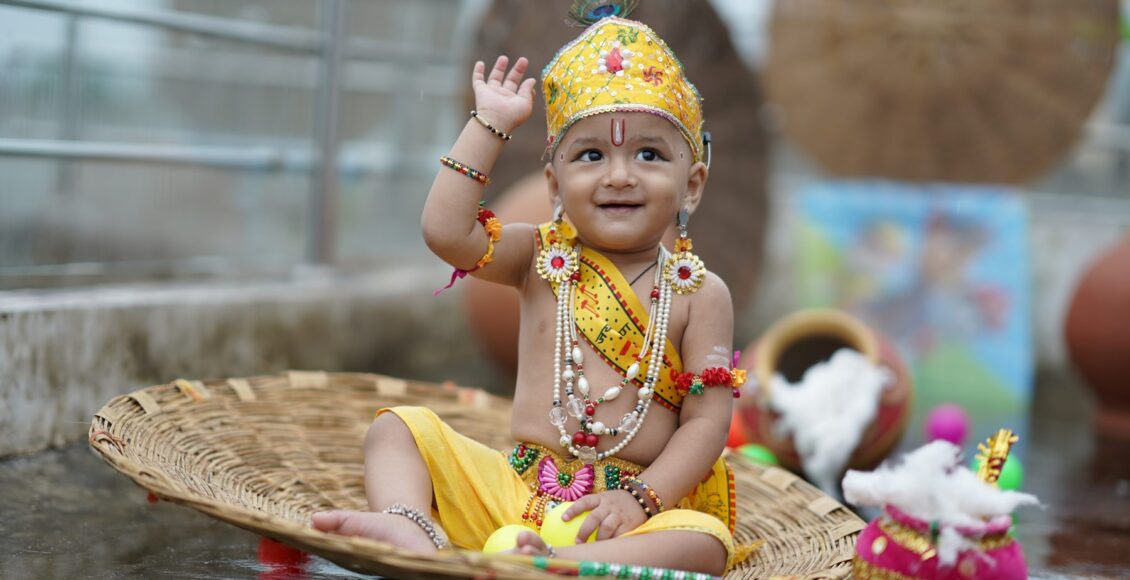Janmashtami : The Birth of Shri Krishna
|
Getting your Trinity Audio player ready...
|
Janmashtami or Gokulashtami is the festival celebrating the day of Shree Krishna’s Divine birth in Mathura. This festival is celebrated on ashtami, the eighth day of the dark fortnight, in the Hindu month of Shravan (August – September).
The festivities spread over two days, with Shree Krishna’s birth being celebrated on the midnight of the first day, and His arrival in Gokul being celebrated on the second day. Janmashtami is a unique festival in that the main celebrations are at midnight – the time when Shree Krishna was born.
About Shree Krishna
Lord Krishna is the Supreme Lord in His all-attractive and loving form. For looking after the affairs of the material world, Shree Krishna expands Himself to take the form of Maha Vishnu. Lord Vishnu governs the material creation, and descends from time-to-time in the material world in the form of various Avatars. Shree Krishna Himself is called Avatari, or the original form of God. He is the source of all the Avatars.
Shree Krishna was the son of Devaki and Vasudev, a king of the Yadavas. Devaki’s brother was the evil Kansa, the king of Mathura. Warned by a Divine voice that his sister’s eighth son would kill him, Kansa decided to kill all of Devaki’s children. He killed the first six sons of Devaki, but her seventh son was miraculously conveyed to womb of Rohini, who was also Vasudev’s wife and was living in Gokul. This child became famous as Balaram, the elder brother of Shree Krishna. The Supreme Lord Himself was born to Devaki, as her eighth child. He asked Vasudev to take Him to Gokul, and leave Him at the house of the chieftain, Nand. Thus, Kamsa’s plan of killing Devaki’s children was laid to waste, and Krishna grew up in Gokul as the son of Nanda and Yashoda, playing pranks with everyone in the village, but loved by all those who laid eyes on Him. Krishna’s pranks and naughtiness earned Him punishments at times, but His innocent smiles drew people to Him like a magnet.
At the age of eleven, Krishna returned to Mathura, and completed the prophecy by killing Kamsa and all his henchmen, thereby liberating Mathura from the tyrant. While Krishna killed many demons and evil kings in His lifetime, that was not the only purpose of His descension.
His loving pastimes with the devotees (called leelas) showed us the power of love, and proved that the only way to bind the Lord was with love. Even as He grew older, He kept illustrating the power of love and devotion through His actions, aiding those who loved Him and were devoted to Him. Through the Bhagavad Geeta, He teaches us the right path to follow in life, to adhere to our duty without worrying about the results. The Bhagavad Geeta also teaches us to stay away from attachment and desires, and to lovingly surrender ourselves to God.
Shree Krishna’s appearance day is celebrated with pomp and splendor, in every corner of India, and by Hindus around the world.
Celebration
In Janmashtami celebrations, the Lord is invited to our house as a small child. Small footprints are drawn from the front door to the prayer room, as if the Lord Himself is walking into our house. People all over India use the day to meditate upon His leelas, by singing kirtans and reading books like the Shreemad Bhagavatam, which describe Him and His actions.

In the prayer room, a small cradle is decorated with flowers, and at the appropriate time (near midnight), a deity of baby Krishna is lowered into the cradle, and people sing songs in His praise, while rocking the cradle. These celebrations last till the early hours of the morning. The offerings to the Lord are of His favorite items – butter, milk, Poha (parched rice), sweets and salty items. The tasty edibles vary from region to region, but they are all eatables loved by the children of that area.
In the morning of Janmashtami, devotees invoke the Lord in His aspect as the naughty prankster, who troubles everyone, but makes them smile through His pranks. The morning celebration is called Nandotsav in some parts of India, and Dahi Handi in other parts. It is a time for fun and merrymaking by the youngsters.
The “Dahi Handi” is a pot of sweet yogurt and butter hung up high, and children try to break it and eat its contents, by climbing up on top of each other in a human pyramid. This is a re-creation of the favorite prank of Krishna, where He and His friends would climb up and break the pots of yogurt hung from the ceilings of the huts of the milkmaids. Over the years this has become an exciting game, one which takes us back to the days of the Lord Himself.
Janmashtami is celebrated all over India with grandeur and devotion, for Krishna is loved all over. The best celebrations are, however, in the land of His birth and and the places He performed His pastimes – Mathura, Vrindavan, Nandgaon, Gokul and Dwarka.


Comments are closed.